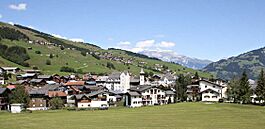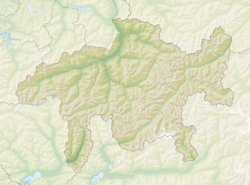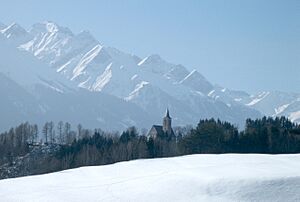Vella facts for kids
Quick facts for kids
Vella
|
||
|---|---|---|
 |
||
|
||
| Country | Switzerland | |
| Canton | Graubünden | |
| District | Surselva | |
| Area | ||
| • Total | 7.38 km2 (2.85 sq mi) | |
| Elevation | 1,244 m (4,081 ft) | |
| Population
(Dec 2011)
|
||
| • Total | 438 | |
| • Density | 59.35/km2 (153.71/sq mi) | |
| Postal code |
7144
|
|
| Surrounded by | Cumbel, Degen, Morissen, Obersaxen, Suraua, Surcuolm | |
Vella is a charming village located in the Graubünden canton of Switzerland. It used to be its own municipality. However, on January 1, 2013, Vella joined with seven other nearby villages. These villages, including Cumbel, Degen, Lumbrein, Morissen, Suraua, Vignogn, and Vrin, all merged to create a new, larger municipality called Lumnezia. Vella is found in the Surselva district.
Contents
Discovering Vella's Past
Vella has a long and interesting history. People lived here as early as the late Bronze Age. Roman coins from the 3rd and 4th centuries have also been found. The village was first written about around the year 840.
Vella's Church and Influence
The church in Vella was very important. It was the main church for the entire valley. Around the year 1300, the village of Vals decided to have its own church leaders. This was because many Walser people, who spoke German, had moved there. Over time, most other villages in the valley also started their own parishes.
Because of its important church and a powerful local family called de Mont, Vella became the strongest village in the valley. Since 1887, Vella has also been home to the local secondary school for the area.
Understanding Vella's Coat of Arms
The coat of arms for Vella shows a silver pelican on a blue background. This symbol is called "A Pelican in Piety Argent."
What the Pelican Symbolizes
In old stories, a pelican was believed to feed its babies with its own blood. This made it a symbol of Jesus's sacrifice. In Vella's case, the pelican represents the main church of the Lugnez valley, which is located in Degen.
Exploring Vella's Geography
Vella covers an area of about 7.4 square kilometers (2.9 square miles). A large part of this land, about 69.5%, is used for farming. Forests cover 18.6% of the area. About 4.6% of the land has buildings or roads, and the rest is natural features like rivers or mountains.
Location and Landscape
Vella is located at an altitude of 1,244 meters (4,081 feet). It sits on a high flat area in the middle of the Lumnezia, which is a high alpine valley. The municipality includes the main village of Vella and the Church of St. Vincent in Pleif. This church is built on a ridge that looks over the deep gorge of the Glenner/Glogn river. The highest point in the area is Mount Stein, which is 2,172 meters (7,126 feet) high.
Before 1987, Vella was known as Villa (GR).
Vella's Population and People
As of 2011, Vella had a population of 438 people. Over the past ten years, the number of people living in Vella has slightly decreased.
Languages Spoken in Vella
Most people in Vella speak Romansh, which is a very old language spoken in parts of Switzerland. About 83.9% of the population speaks Romansh. German is the second most common language, spoken by 13.6% of the people. A small number of people also speak Serbo-Croatian.
Education and Jobs
Many adults in Vella have completed higher education. About 70.7% of people aged 25-64 have finished either upper secondary education or a university degree.
Vella has a low unemployment rate, meaning most people who want to work have jobs. In 2005, there were 17 people working in farming and related businesses. The manufacturing sector employed 66 people. The service sector, which includes jobs like tourism and shops, employed 101 people.
Historical Population Figures
Here's how Vella's population has changed over the years:
| Year | Population |
|---|---|
| 1808 | 199 |
| 1835 | 301 |
| 1850 | 229 |
| 1900 | 272 |
| 1950 | 418 |
| 1990 | 398 |
| 2000 | 441 |
Weather in Vella
Vella experiences about 116 days of rain or snow each year. On average, it receives about 1,004 millimeters (39.5 inches) of precipitation.
Wet and Dry Seasons
The wettest month in Vella is August, with an average of 115 millimeters (4.5 inches) of rain or snow over about 11.5 days. May has the most days with precipitation, around 11.7 days, but with slightly less rain or snow. The driest month is February, which gets about 55 millimeters (2.2 inches) of precipitation over 11.5 days.
Important Heritage Sites
The Church of S. Vincenz/St. Vincent in Vella is a very important historical site in Switzerland. It is listed as a national heritage site.
History of St. Vincent Church
The church was first mentioned around the year 843. It received support from the emperor at that time. Later, it came under the control of the Welf family and then the cathedral of Constance. By the 14th century, it was owned by the Freiherr of Belmont. In 1483, it came under the authority of the Bishop of Chur. The church, which has a mix of Gothic and Romanesque styles, was rebuilt in 1661-62.
See also
 In Spanish: Vella para niños
In Spanish: Vella para niños






